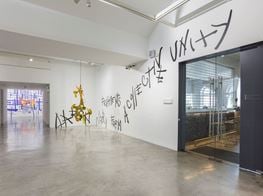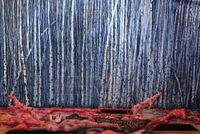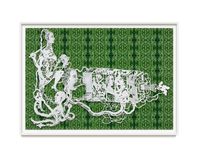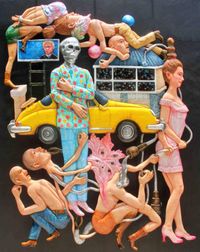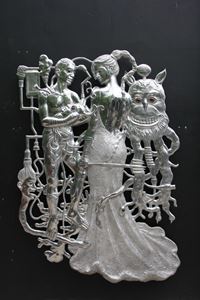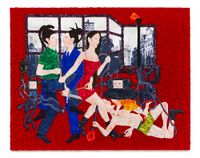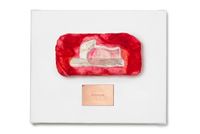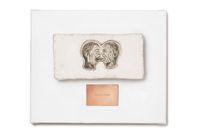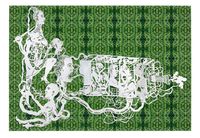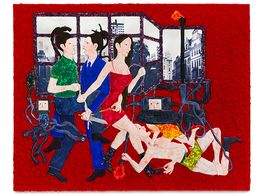Entang Wiharso
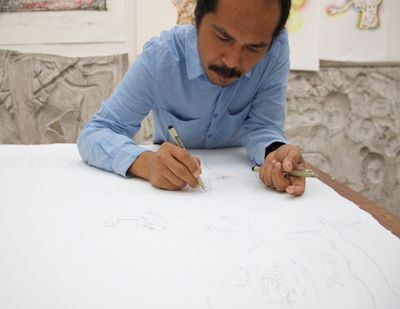
One of Indonesia’s most acclaimed contemporary artists, Entang Wiharso was born in 1967 in Tegal, Central Java. He studied painting, graduating from the Indonesian Institute of Arts in Yogyakarta in 1987 and is widely regarded for his dramatic visual language which draws on popular culture and ancient mythology to create unique images of contemporary life.
A recipient of numerous award and residencies including a Pollock-Krasner grant, a Copeland Fellowship at Amherst College, and a summer residency at Robert Wilson’s Watermill Center, Entang Wiharso has exhibited throughout the world and represented Indonesia in major international biennales. Recent exhibitions include Art Stage Singapore 2014, the 51st and 55th Venice Biennale, Prague Biennale 6, Yogyakarta Biennale XI and Panorama at the Singapore Art Museum. He is represented in numerous notable collections including the Guy and Myriam Ullens Foundation, Switzerland; the Olbricht Collection, Germany; Indonesian Art Institute, Yogyakarta; National Gallery of Victoria, Melbourne, Australia; Rubell Family Collection, Miami USA; and the Singapore Art Museum.
He lives and works in Rhode Island, USA and Yogyakarta, Indonesia.
Ocula talks to Entang Wiharso on the occasion of his residency at STPI. A new body of work, created during the residency, will be exhibited at STPI in April 2015.
Congratulations on your residency at the STPI. I understand print making has not been a large part of your practice to date. How have you enjoyed the experience? What have been the challenges?
Actually my wife is a graduate of Carnegie Mellon University and specialized in printmaking. She introduced it to me. As a medium of expression, I find it challenging because it is not my normal practice. However, the incredibly competent team at STPI, especially Eitaro the master Print Maker, has given critical support in developing this area of my oeuvre. I have really enjoyed working with the solid and professional team, and the facility is the best in this region. This collaborative environment requires a high degree of focus and I have enjoyed the experimentation that has occurred. I find a challenging situation is often the most beneficial; it holds my attention and keeps me “awake.”
Can you tell us about the new works? You have been working with new materials as well as incorporating alternative materials such as wire and nails into the process?
A review of my work, particularly my painting, shows that this combination of materials and the incorporation of non-traditional or non-typical objects has been a part of my creative process in the past. I have been interested in the themes I am exploring at STPI for some time. However, the unique environment has given me a different awareness and fostered a new intensity. The work reflects the entire environment, the STPI team and the studio conditions. The situation is very special and I am able to express something unique to the time and place. I think it is impossible to create the same art work in different environments.
And do they relate to the universal themes common to your painting and sculpture – power, love, alienation, fanaticism, optimism and loss etc? Or has the experience opened up some new directions for you?
The work does build on certain areas of interest to me, but I think people will see a new direction in the work. The conditions in the studio have provided the impetus to some new imagery and different aesthetic vocabulary.
Going forward what do think you will take away from this experience working with print making at the STPI?
We all know that our experiences shape us. Although I can’t define today what that will be, I am confident that this experience will have an impact.
More generally, I am interested in the use of written text in your practice in recent years. Can you talk to us about the use of text and what triggered this direction in your practice?
It started when I discovered a miss-spelling in a painting I had made and realized that this mistake embodied the sensation of always being not quite right, not quite able to fit in. I understood I could use this as a tool to communicate these experiences and states of being that are so important in my work. I was already actively collecting texts and slogans, but began to really develop the use of language and phrases in my work and they have become an important component.
Also, your Indonesian heritage plays a significant role in your work yet you have often spoken about how you do not wish to be limited to an Indonesian identity. How much of your work is autobiographical and how do you see yourself within the context of contemporary Indonesian art today?
I am Indonesian and I embrace my heritage and my culture, but I am not looking to promote it as a product. I am open to becoming an internationalist by absorbing and modifying who I am and how I think. I have had the benefit of travel and exposure to other cultures. At this point in my life, I am able to compare the commonality between people and their differences. As I developed my career, first in Indonesia and then internationally, I was not part of a group nor did I have privileged connections. I was often on the outside, and not embraced, and this helped me to develop a strong critique of social norms. One by-product of this exploration in my work was the creation of my “Black Goat” identity, which channels both the position of outsider (black sheep) and scapegoat. This feeling of being autonomous and misunderstood was channeled into work about identity and art politic.
There has been much discussion about the rise of Indonesian contemporary art over the past decade. Can you offer some thoughts about the current state of the Indonesian Art world? Your residency at STPI for example brings to mind the question of arts infrastructure in Indonesia. In your mind, what are the most significant changes taking place and what are you hopes for the future of Indonesian art?
Indonesia as a country has become more recognized around the world and people are paying more attention to the art, politics and economic opportunities. With this new recognition a “party like” feeling has emerged in the art scene. I don’t like big parties. I prefer a more intimate coffee klatch. I like one-on-one. In fact the strongest part of the Indonesian art world infrastructure is the studio practice of artists. Also, most developments are artist-driven with artists creating their own organizations and institutions, residency programs and exhibition centers. Of course, sometimes these efforts do not always create consistent, stable organizations, but I think sometimes we don’t need to create permanent organizations or institutions. I hope in the future the Indonesian art world continues to create excellent projects and artists continue their leadership role.
Exhibitions of your work are always highly anticipated. Please tell us about some of the projects you have coming up.
I will be exhibiting work at Prospect3, the New Orleans Biennale opening this month and a solo show opening at Marc Straus Gallery, New York in January 2015.—[O]

